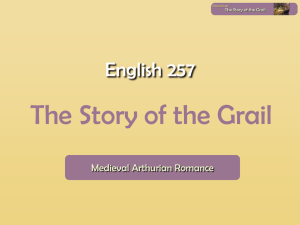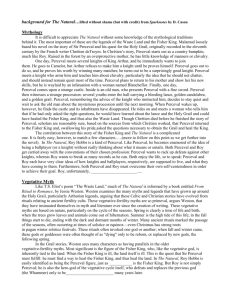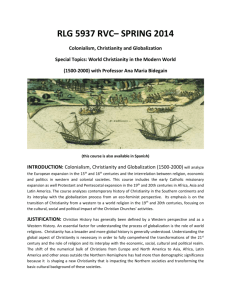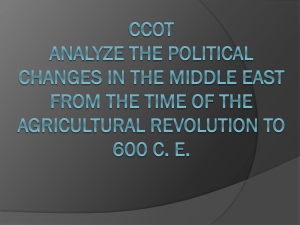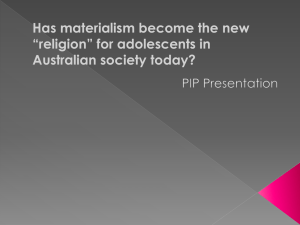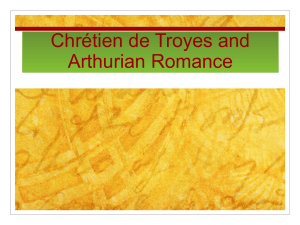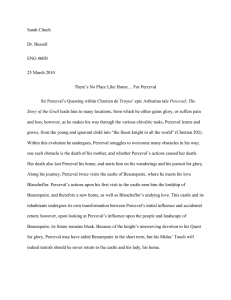War and Peace in Chretien`s Perceval.
advertisement
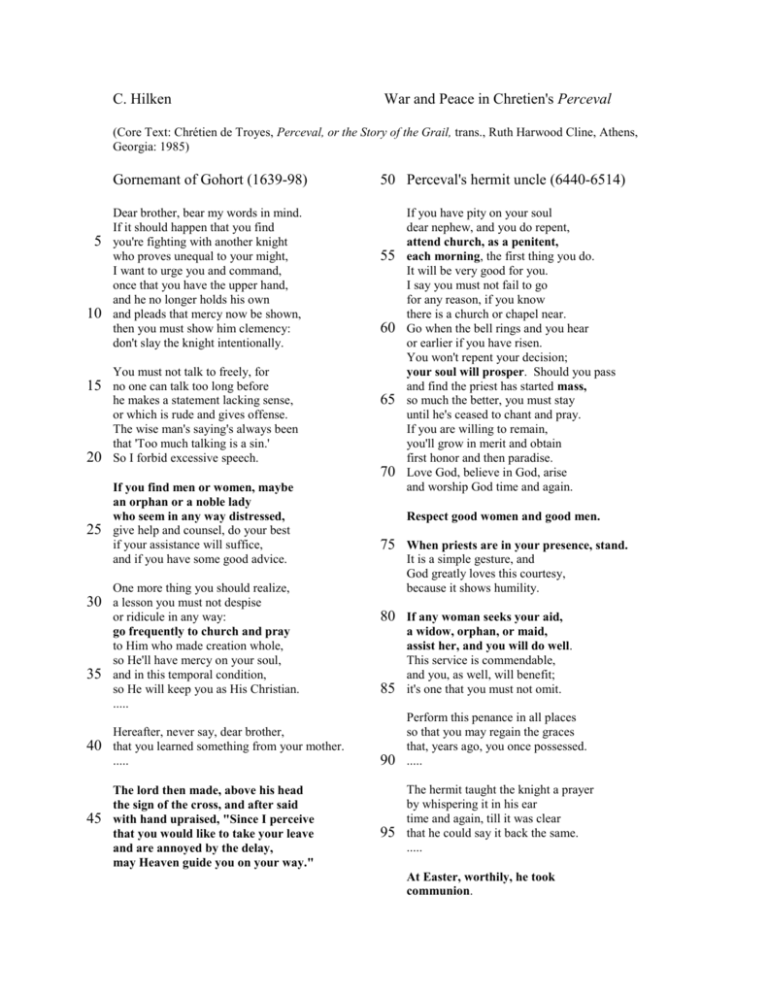
C. Hilken War and Peace in Chretien's Perceval (Core Text: Chrétien de Troyes, Perceval, or the Story of the Grail, trans., Ruth Harwood Cline, Athens, Georgia: 1985) Gornemant of Gohort (1639-98) 5 10 Dear brother, bear my words in mind. If it should happen that you find you're fighting with another knight who proves unequal to your might, I want to urge you and command, once that you have the upper hand, and he no longer holds his own and pleads that mercy now be shown, then you must show him clemency: don't slay the knight intentionally. 50 Perceval's hermit uncle (6440-6514) 55 60 You must not talk to freely, for 15 no one can talk too long before 20 he makes a statement lacking sense, or which is rude and gives offense. The wise man's saying's always been that 'Too much talking is a sin.' So I forbid excessive speech. 65 70 25 If you find men or women, maybe an orphan or a noble lady who seem in any way distressed, give help and counsel, do your best if your assistance will suffice, and if you have some good advice. If you have pity on your soul dear nephew, and you do repent, attend church, as a penitent, each morning, the first thing you do. It will be very good for you. I say you must not fail to go for any reason, if you know there is a church or chapel near. Go when the bell rings and you hear or earlier if you have risen. You won't repent your decision; your soul will prosper. Should you pass and find the priest has started mass, so much the better, you must stay until he's ceased to chant and pray. If you are willing to remain, you'll grow in merit and obtain first honor and then paradise. Love God, believe in God, arise and worship God time and again. Respect good women and good men. 75 When priests are in your presence, stand. It is a simple gesture, and God greatly loves this courtesy, because it shows humility. One more thing you should realize, 30 a lesson you must not despise 35 40 45 or ridicule in any way: go frequently to church and pray to Him who made creation whole, so He'll have mercy on your soul, and in this temporal condition, so He will keep you as His Christian. ..... Hereafter, never say, dear brother, that you learned something from your mother. ..... The lord then made, above his head the sign of the cross, and after said with hand upraised, "Since I perceive that you would like to take your leave and are annoyed by the delay, may Heaven guide you on your way." 80 If any woman seeks your aid, 85 a widow, orphan, or maid, assist her, and you will do well. This service is commendable, and you, as well, will benefit; it's one that you must not omit. 90 Perform this penance in all places so that you may regain the graces that, years ago, you once possessed. ..... 95 The hermit taught the knight a prayer by whispering it in his ear time and again, till it was clear that he could say it back the same. ..... At Easter, worthily, he took communion. 2 Introduction My remarks today are about Chretien de Troyes' Perceval, or the Search for the Grail, a vernacular poem written ca. 1180; the last work of the author. The translation I am using is by Ruth Cline, 5 published by University of Georgia Press in 1985. Chretien's poem is arguably the oldest witness to Perceval and the Grail story. He had many cultural and historical sources to draw from. Joseph Goering, a professor at the University of Toronto, has argued that Chretien drew inspiration from a real-life crusader named Routrou the Great, Count of La Perche, as well as from reports of church art in the Pyrhenees depicting the glowing grail in the hands of 10 Saint Mary the mother of Jesus.1 Chretien had also at his disposal the new learning of the cathedral and monastic schools, as well as the lore of Celtic stories of nearby Brittany. The question I want to ask is about a particular aspect of Chretien's story, that of its Christianity. What kind of Christianity do we meet in the tale? This may seem an odd question. But what I have in mind is a distinction between a secular Christianity that we find in the piety of warriors' tales—it is useful 15 to think here of The Poem of the Cid— and the Christianity of the monasteries, where the dominant warrior culture did not have so tight a grip. Two passages in the poem serve to illustrate the two kinds of Christianity. One is from a knight, the uncle of Blancheflor, Perceval's damsel in distress. The other is from Perceval's hermit uncle. Both the older knight and the hermit enjoin upon Perceval the duty of helping others, in fact this exhortation is more 20 pronounced in the knight’s counsel. Both urge the young knight to go to church, but here the hermit’s counsel is more elaborate. In fact, the hermit is an eloquent spokesman for the new church of the Gregorian Reform, with its highly developed sacramental-hierarchical sensibility. Perceval is to honor priests by standing in their presence and thereby acknowledge the distance between himself as a layman and the ministerial priesthood. The passage ends with Perceval going to mass and receiving communion. 25 The visit to the older knight has no mention of priests or sacraments. In stark contrast to the ending of hermit passage, here Sir Gornemont, a layman, makes the sign of the cross over Perceval and blesses him on his way. Gornemont belongs to an older world of vibrant lay leadership where he who wields the sword 1 Joseph Goering, The Virgin and the Grail (New Haven: 2005) 3 thereby does the work of the Church. Gornemont’s Christianity is at home in the world of the poet. The hermit’s Christianity needs some explanation. It is important to point out the monastic context of the poem. We know that our author traveled in courtly circles and probably would have identified most strongly with that culture. So his awareness of 5 monastic Christianity may not be so obvious. But no one in Chretien's day was very far from the monastic world. Three passages in the poem remind us of the ubiquity of monastic life in Chretien's world. Gawain (5656-5658) 10 The lord Gawain, that evening, slept in a grange close to a monastery. The grange in question is either a new Cistercian house inhabited by conversi or an old Benedictine rural chapel with adjoining communal house. The scene depicted is not meant to make it seem 15 that Gawain was remote from civilization. On the contrary, the grange reminds us of the ubiquity of monastic houses. Blancheflor (1910-1914) 20 I have five white rolls which, with one small flask of boiled wine, were sent here by an uncle of mine, a saintly and religious prior, for me to eat when I retire 25 Almost a hundred years ago Ursmer Berlière, a Belgian Benedictine at the abbey of Maredsous, showed how extensive the monastic family was.2 Analogous to the reach of an old Roman family structure encircling near relations, household servants, clients and dependents, the monastic family embraced the vowed religious of the chapter room, adult converts, the poor, servants and ministers, benefactors, and 30 prebendaries dependent on the support of the house for sustenance. In light of what we know about the reach of the monastic familia, we can assert that Blancheflor was prebendary of her prior uncle’s community, someone who by contract received food and drink as if she were one of the monks. Perceval and his uncle (6341-6345) 35 2 Ursmer Berlière, “La Familia dans les monastères bénédictins du moyen âge,” Mémoires de l’Académie Royale de Belgique, Classe des lettres et des sciences morales et politiques, second series 29 (1931) 1-123. 4 5 The young knight found, when he went in, the hermit, ready to begin the service in a chapel small, with him a priest, and they were all assisted by an acolyte. This passage reminds us that hermits are more often than not defined in relation to monasteries. The attendant priest and acolyte are not identified as monks, but it is a reasonable assumption that they were themselves from some religious community. Twelfth century church history is filled with the record 10 of new monastic experiments, and close associations between lay monks and canons. The hermits of the eleventh and twelfth centuries either had passed beyond the confines of cenobitic life, or their sanctity became an occasion for its renewal. Without some evidence of Chretien's contact with monasticism it would be hard to raise an argument about competing views of Christianity. Pacifism is certainly a minority report from this era in 15 European history. In a passage cited by Richard Southern in The Making of the Middle Ages, Anselm of Canterbury exhorts a monk not to leave the monastery to become a crusader, arguing that the true Jerusalem is a heavenly one found in the Christian community of the monastery. Thirty years after Chretien's book Europe would see a vibrant example in Francis of Assisi of a crusader abandoning the soldier's life to become an apostle of peace. We know even that Francis first found support for his 20 experiment among the Benedictine monks of San Pietro in Assisi. Dawson's Two Christianities 25 The existence of two Christian cultures was perhaps put best more than eighty years ago by Christopher Dawson. The following is a somewhat lengthy passage from his work, The Making of Europe. 30 35 40 It is impossible to understand early medieval culture on the analogy of modern conditions, which are based on the conception of the single all-inclusive society of the sovereign state. There were in fact two societies and two cultures in early medieval Europe. On the one hand there was the peace-society of the Church, which was centred in the monasteries and episcopal cities and inherited the tradition of later Roman culture. And, on the other hand, there was the war-society of the feudal nobility and their following, whose life was spent in incessant wars and private feuds. Although the latter might be affected personally by the influence of the religious society, whose leaders were often their own kinsmen, they belonged socially to a more primitive order. They were the successors of the old tribal aristocracies of barbarian Europe, and their ethos was that of the tribal warrior. At the best they preserved a certain rude measure of social order and protected their subjects from external aggression. But in many cases they were purely barbarous and predatory, living in their strong-holds, as a medieval chronicler 5 5 writes, “like beasts of prey in their dens,” and issuing forth to burn their neighbours’ villages and to hold the passing traveller ransom. The vital problem of the tenth century was whether this feudal barbarism was to capture and absorb the peace-society of the Church, or whether the latter could succeed in imposing its ideals and its higher culture on the feudal nobility, as it had formerly done with the barbarian monarchies of the Anglo-Saxons and the Franks. (Dawson, The Making of Europe, p. 239) Perhaps Dawson was a little too sweeping in his negative view of the war-society. This culture included 10 lay lords who did double duty as both warriors and advocates of unarmed monasteries and churches. The tranquility of life as villager or professed religious, I would say, depended on the religious sensibilities of one’s local warlord. Chretien lived almost two centuries after the time described by Dawson, but the struggle he described of two competing cultures is evident in his poem. One could easily argue that the code of chivalry exemplified in Perceval is evidence of the war-society trying to come to some accord with 15 the peace-society, but in a push-me, pull-you sort of fashion. Violence is clearly still celebrated in the poem. Richard Southern, in The Making of the Middle Ages, puts Chretien in line with warrior Christianity. Southern's enamel Christianity 20 25 30 Chretien, as an author, was neither religious nor, in intention at least, anti-religious. Religion was part of the furniture of his stories—indeed an essential part, for religious observance was one of the elements of good breeding. But the Christianity of Chretien is an affair of externals, providing plenty of bishops and clerks to add to the dazzling throng, and a rich pageantry of mitres and croziers at weddings. The real internal religion of the heart was untouched by Christianity. There is in Chretien none of the melancholy, none of the sense of the sinfulness of the heart, which we sometimes find in Malory. Chretien probes the heart, but it is an enameled heart of the twelfth-century secular world, not yet made tender by the penetration of strong religious feeling. There is nothing in Chretien like the passage of the Morte d’Arthur when Guinevere takes leave of Lancelot. The religious and the romantic quests were born in the same world—Troyes is only about thirty miles from Clairvaux—and drew in part on the same sources of inspiration, but they were in the twelfth century kept rigidly apart. They were indeed the great alternatives opened out to the imagination in the mid-twelfth century. (Southern, The Making of the Middle Ages, pp. 245-246) 35 It may be reckoned an overstatement to say that the internal religion of chivalric romance was untouched by Christianity, unless one qualifies the absent quality as the monastic Christianity described by Dawson. Gornemont, the uncle of Blancheflor and tutor of Perceval, is certainly Christian, as devoutly Christian as any God-fearing man of violence. To invoke again The Poem of the Cid, Ruy Diaz de Vivar’s 40 passion for his religion is as true as his warrior’s ethos. The in-breaking of pacific Christianity 6 Consider now the evidence of Perceval, and whether and how much the poem reveals its author as mindful of monastic Christianity. The violence of the poem, though described with reserve, is frequent and the proud disdain for the lower classes untrained in warfare is palpable. It is easy therefore to tend towards Southern’s judgment of chivalric religion. Yet in the reverence for the clergy we find in the 5 hermit's advice, and in the penance he enjoins on his nephew, and even more in the spiritual quest he confirms in Perceval, one might argue that Chretien here is midwife to the emergence of a more pacific Christianity in the secular world which the thirteenth century will give evidence of, especially in the striking examples found in early Franciscan history. Chretien's Perceval certainly isn't ready to drop out of society and head for the desert, but his tale we might imagine may well have had the power to push more 10 spiritually restless youth beyond the perfection defined by Gawain to the more open-ended and uncertain path on which we last glimpse Perceval in the poem. An argument teased out by my students in discussion of the story is intriguing. The Story of the Grail introduces the idea of quests, unending quests or the unending series of quests that drive heroes into the world. The quests in Chretien’s poem are varied. The central one is that of the grail and the opportunity to ask its meaning. This quest will occupy the young 15 hero Perceval and eventually lead him away from the theater of activity. The other major quest in the story is of the bleeding lance. Gawain, nearer by birth and training to the courtly world of knighthood, seeks the lance.3 Though originally part of the same vision in the castle of the Fisher King, the desire to know the meaning of the grail on the one hand and the recovery of the lance on the other, lead the two heroes on two different quests. The military association of the lance is obvious. Chretien’s grail, though not yet the 20 sacred cup of the Last Supper, glows with a sacramental light and the promise of spiritual nourishment. Did Chretien see beyond the enameled court of nascent chivalry? The words of his hermit uncle and their effect on Perceval make it seem so. The divide between the cultural worlds of chivalry and monastic Christianity and by extension Christian pacifism seems wide and deep in the twelfth century. Yet living boundaries are always more porous. Even without much evidence of the author Chretien’s journey 25 beyond courtly confines, his Perceval’s journey could point to the reception of his book by seekers tuned to 3 Perceval, p. 165: (At Escavalon) “His trial by combat for his crime / should be postponed for one year’s time. / Instead, the lord should make a trip / to seek the lance whose iron tip / bleeds even when it is wiped clean.” 7 the Gospel’s irenic tenets, such seekers as Francis of Assisi a generation later and university students today attuned to social and spiritual needs not easily met by reigning conventional wisdom.

